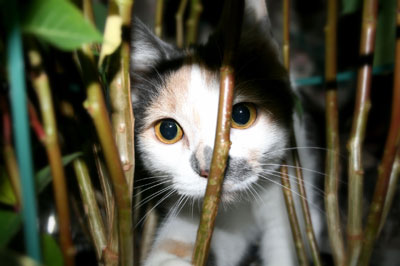All Nonfiction
- Bullying
- Books
- Academic
- Author Interviews
- Celebrity interviews
- College Articles
- College Essays
- Educator of the Year
- Heroes
- Interviews
- Memoir
- Personal Experience
- Sports
- Travel & Culture
All Opinions
- Bullying
- Current Events / Politics
- Discrimination
- Drugs / Alcohol / Smoking
- Entertainment / Celebrities
- Environment
- Love / Relationships
- Movies / Music / TV
- Pop Culture / Trends
- School / College
- Social Issues / Civics
- Spirituality / Religion
- Sports / Hobbies
All Hot Topics
- Bullying
- Community Service
- Environment
- Health
- Letters to the Editor
- Pride & Prejudice
- What Matters
- Back
Summer Guide
- Program Links
- Program Reviews
- Back
College Guide
- College Links
- College Reviews
- College Essays
- College Articles
- Back
Tabby Cats
The exact history of the tabby is unknown. The tabby pattern is believed to be the original basic cat pattern, and the closest to their distant ancestors. Also, since the tabby pattern is a common wild type, it might be assumed that medieval cats were of tabby type. The word tabby seems to come from the Arabic attabiyah originally referring to a kind of striped silk, and later to describe striped cats.
The tabby is not really its own breed. The tabby is a domestic short hair, but has its own name because of its coat. The coat has unique designs specific to the tabby. All tabby cats have a brick red or rose-colored nose and light-colored areas around the eyes.
The tabby is found in four different patterns, classic, mackerel, spotted, and agouti. A classic has whorls ending in a “target” on the side of the cat. The mackerel has stripped rings around there tail and legs, a “collar” of stripes on the front of their chests, and band of solid or broken stripes running down the sides of their bodies. They will have the darker color in spots running in two lines down their tummies, sometimes called “vest buttons.” This is the most common. The spotted have no lines, but what are lines in other tabbies are broken up into a number of spots. Lastly the agouti has hair with distinct bands of color on them which breaks up the tabby patterning into a salt-and- pepper appearance. Residual ghost striping or “barring” can often be seen on the face, belly, and lower legs, and sometimes, at the tail tip. One of the most distinguishing features of a tabby is the “M” on the forehead.
Some common health problems in a tabby are obesity, diabetes, conjunctivitis, kidney problems, and urine problems. Obesity can be easily avoided by not over feeding. Conjunctivitis is most common in older cats but is sometimes found in the younger ones. The other three are medical issues. All of these health issues are common in all cat breeds but some of them are most common in tabby cats. These are just the most common health problems found in the Tabby.

Similar Articles
JOIN THE DISCUSSION
This article has 1 comment.

0 articles 0 photos 188 comments
Favorite Quote:
"We accept the love we think we deserve." -Stephen Chbosky